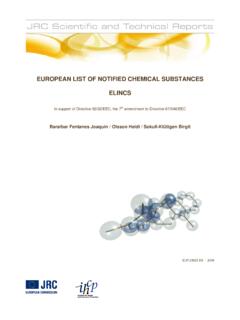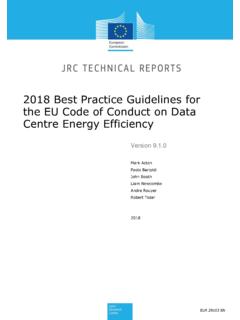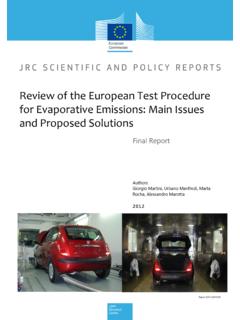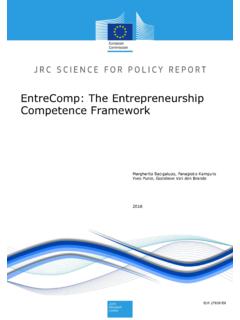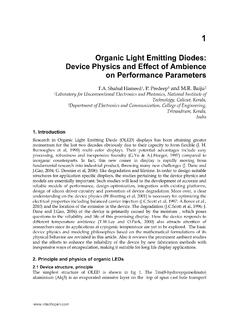Transcription of Organic Light Emitting Diodes (OLED) ONLINE Final1
1 Georges Zissis Paolo Bertoldi 2014 Status Report on Organic Light Emitting Diodes (OLED) 2014 Report EUR 26999 EN European Commission Joint Research Centre Institute for Energy and Transport Contact information Paolo Bertoldi Address: Joint Research Centre, Via Enrico Fermi 2749, TP 450, 21027 Ispra (Italy) Tel.: +39 0332 789299 Legal Notice This publication is a Science and Policy Report by the Joint Research Centre, the European Commission s in-house science service. It aims to provide evidence-based scientific support to the European policy-making process. The scientific output expressed does not imply a policy position of the European Commission. Neither the European Commission nor any person acting on behalf of the Commission is responsible for the use which might be made of this publication.
2 All images European Union 2014, except: The image on the cover page belongs to UNIVERSIT TOULOUSE III - Paul Sabatier "pictures of this report are from literature and all references/credits are mentioned for each one individually" JRC92975 EUR 26999 EN ISBN 978-92-79-44654-2 (PDF) ISBN 978-92-79-44655-9 (print) ISSN 1831-9424 ( ONLINE ) ISSN 1018-5593 (print) doi: Luxembourg: Publications Office of the European Union, 2014 European Union, 2014 Reproduction is authorised provided the source is acknowledged. Abstract Organic Light Emitting Diodes (OLED) are promising candidates for general illumination, since they offer the possibility to realize large area Light sources which can even be transparent and flexible. The energy-saving potential of OLEDs is similar to that of LEDs, but the two technologies differ in a number of ways.
3 The present report introduces the basics of the OLED technologies and its latest developments. It also describe the emerging markets, industry landscape and standardisation requirements Table of Contents INTRODUCTION .. 3 BASICS OF THE OLED TECHNOLOGY .. 5 EVOLUTION OF THE OLED TECHNOLOGY AND TARGETS .. 10 OLED VALUE CHAIN AND INDUSTRY LANDSCAPE .. 16 OLED INDUSTRY ECOSYSTEM .. 18 OLED DEVELOPMENT PUBLIC SUPPORT (FROM [DOE-14]) .. 22 OLED MARKET .. 24 OLED PRICES AND POTENTIAL DOWNSIZING .. 26 OLED STANDARDS .. 30 ACRONYMS .. 32 CURRENCY RATES USED (JULY 2014) .. 32 REFERENCES .. 33 Organic electronics are still a young area of technology that comprises applications as diverse as illuminants, photovoltaics, printed electronics and batteries. Replacing inorganic by Organic materials, in particular conversion of Light to electrical current (photovoltaics) and electrical current to Light ( Light Diodes ), are promising basic economic and ecological benefits as well as benefits regarding application options and design, for large-area lighting, flexible displays and generation of energy [ACA-11].
4 Organic Light Emitting Diodes (OLED) are promising candidates for general illumination, too, since they offer the possibility to realize large area Light sources which can even be transparent and flexible. The energy-saving potential of OLEDs is similar to that of LEDs, but the two technologies differ in a number of ways. The following table compares LED and OLED technologies. An OLED ( Organic Light - Emitting diode ) is a Light - Emitting diode (LED) in which the emissive electroluminescent layer is a film of Organic compound that emits Light in response to an electric current. OLEDs are used to create digital displays in devices such as television screens, computer monitors, portable systems such as mobile phones, handheld game consoles and PDAs. A major area of research is the development of white OLED devices for use in solid-state lighting applications.
5 While there has recently been a dramatic expansion in the use of OLEDs for displays, a direct impact on the cost of OLED lighting products is not yet evident [DOE-13]. Partly this is because OLED lighting manufacturing is still evolving and the device architectures and performance requirements are different than those for displays. Nevertheless, today several OLED products for general lighting are already available. OLEDs offer yet another Light source technology with unique spectral power densities. The broad spectrum of OLED emission peaks allows for full coverage of the visible spectrum; however, red emission in the infrared regime and the lack of efficient, long-life blue emitters limit options in terms of optimizing the trade-off between colour quality and efficacy. [DOE-14]. Most OLED panels emit Light over a complete hemisphere, with a distribution close to lambertian, this is a fundamental difference from other lighting technology.
6 Unlike existing Light sources, such as incandescent Light bulbs and fluorescent lamps, OLEDs are planar Light emitters that are lightweight and have thin profiles. This allows lamp manufacturers and designers to create unprecedented designs and provide dramatic effects, leading to the creation of new living environments in houses, offices, stores, and vehicles such as cars and airplanes. In principle, OLEDs emit UV-free pleasant Light with a high Colour Rendering Index (CRI). An OLED device with broad spectrum can achieve a radiant efficacy1 as high as 325 lm/W and, possibly, this value can goes up to 400 lm/W. However, an early NanoMarker white paper pointed-out that Organic electronics is in no position to replace silicon, but there are many applications for which Organic materials currently offer a competitive or superior mix of performance and economics, their number is growing, and the opportunity for materials firms is substantial [NAN-08].
7 Basics of the OLED technology An OLED is a solid-state device consisting of a thin, carbon-based semiconductor layer that emits Light when electricity is applied by adjacent electrodes. In order for Light to escape from the device, at least one of the electrodes must be transparent. The intensity of the Light emitted is controlled by the amount of electric current applied by the electrodes, and the Light 's colour is determined by the type of emissive material used. The basic structure of an OLED consists of a thin film of Organic material (typical thickness in the order of 100nm) sandwiched between two electrodes, as depicted in Fig. 1, all deposited on a substrate. Figure 1: Typical structure of a bottom- Emitting OLED Today, different stack structures are possible: Bottom or top emission (Figure 2): Bottom or top distinction refers not to orientation of the OLED display, but to the direction that emitted Light exits the device.
8 OLED devices are classified as bottom emission devices, if emitted- Light pass through the transparent or semi-transparent bottom electrode and substrate on which the panel was manufactured. Top emission devices are classified based on whether or not the Light emitted from the OLED device exits through the lid that is added following fabrication of the device. 1 Radiant efficacy is defined as the ratio between emitted the luminous flux (lm) over the emitted power (W) across all wavelengths Transparent OLEDs (Figure 2): This uses use transparent or semi-transparent contacts on both sides of the device to create displays that can be made to be both top and bottom Emitting (transparent). TOLEDs can greatly improve contrast, making it much easier to view displays in bright sunlight.
9 This technology can be used in Head-up displays, smart windows or augmented reality applications. Inverted OLED: In contrast to a conventional OLED, in which the anode is placed on the substrate, an Inverted OLED uses a bottom cathode that can be connected to the drain. This technology is more common for displays than for lighting. Figure 2: Bottom Emitting OLED (left and top); Top Emitting OLED (left and bottom); Transparent OLED (right) [from: ] Organic electroluminescent materials, based on -conjugated molecules may be electrically conductive as a result of delocalization of -electrons caused by conjugation over part or the entire molecule. These materials have conductivity levels ranging from insulators to conductors, and are therefore considered Organic semiconductors. In Organic semiconductors the highest occupied and lowest unoccupied molecular orbitals (HOMO and LUMO) of Organic semiconductors are analogous to the valence and conduction bands of inorganic semiconductors.
10 During operation, a voltage is applied across the OLED such that the anode is positive with respect to the cathode. A current of electrons flows through the device from cathode to anode, as electrons are injected into the LUMO of the Organic layer at the cathode and withdrawn from the HOMO at the anode. This latter process may also be described as the injection of electron holes into the HOMO. Electrostatic forces bring the electrons and the holes towards each other and they recombine forming an exciton, a bound state of the electron and hole. This happens closer to the emissive layer, because in Organic semiconductors holes are generally more mobile than electrons. The decay of this excited state results in a relaxation of the energy levels of the electron, accompanied by emission of radiation whose frequency is in the visible region.
